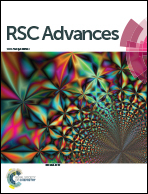Retracted Article: Promising antimicrobial and antibiofilm activities of reduced graphene oxide-metal oxide (RGO-NiO, RGO-AgO, and RGO-ZnO) nanocomposites
Abstract
Microbial infections are considered one of the most dangerous infections in humans due to their resistance to most antimicrobial agents. In this study, nanocomposites based on reduced graphene oxide (RGO) and metal oxides (NiO, AgO, and ZnO) were fabricated. The graphite precursor and RGO were characterized by XRD, Raman spectroscopy, SEM, and HRTEM, while SEM, XRD, and EDX mapping analysis validated the synthesized nanocomposites. In addition, ZOI and MIC were employed to test the antimicrobial potential, while their antibiofilm activity and the effect of UV illumination were also investigated. Finally, reaction mechanism determination was performed using SEM analysis. The results revealed that all the synthesized nanocomposites (RGO-NiO, RGO-AgO, and RGO-ZnO) had outstanding antimicrobial activity against Gram-negative bacteria (Escherichia coli and Pseudomonas aeruginosa), Gram-positive bacteria (Staphylococcus aureus and Bacillus subtilis), unicellular fungi (Candida albicans and Cryptococcus neoformans) and multicellular fungi (Aspergillus niger, A. terreus, A. flavus and A. fumigatus). Moreover, the synthesized RGO-NiO nanocomposite exhibited antibiofilm activity (following 10.0 µg mL−1 RGO-NiO), with an inhibition percentage of 94.60% for B. subtilis, 91.74% for P. aeruginosa, and 98.03% for C. neoformans. The maximum percentage inhibition under UV illumination toward P. aeruginosa, B. subtilis and C. neoformans at the end of the experiment using RGO-NiO were 83.21%, 88.54%, and 91.15%, respectively, while the values of RGO-AgO were 64.85%, 68.0%, and 80.15%, respectively, and those of RGO-ZnO were 72.95%, 82.15%, and 79.25%, respectively. The SEM analysis of C. neoformans in the absence of the RGO-NiO nanocomposite showed the development of unicellular fungal cells by regular budding. In contrast, after RGO-NiO treatment, noticeable morphological differences were identified in C. neoformans, including the lysis of the outer surface with deformations of the fungal cells. In conclusion, the prepared nanocomposites are promising antimicrobial and antibiofilm agents and can be used to treat the pathogenic microbes at low concentrations and represent a new strategy for managing infectious diseases caused by pathogenic microorganisms.



 Please wait while we load your content...
Please wait while we load your content...